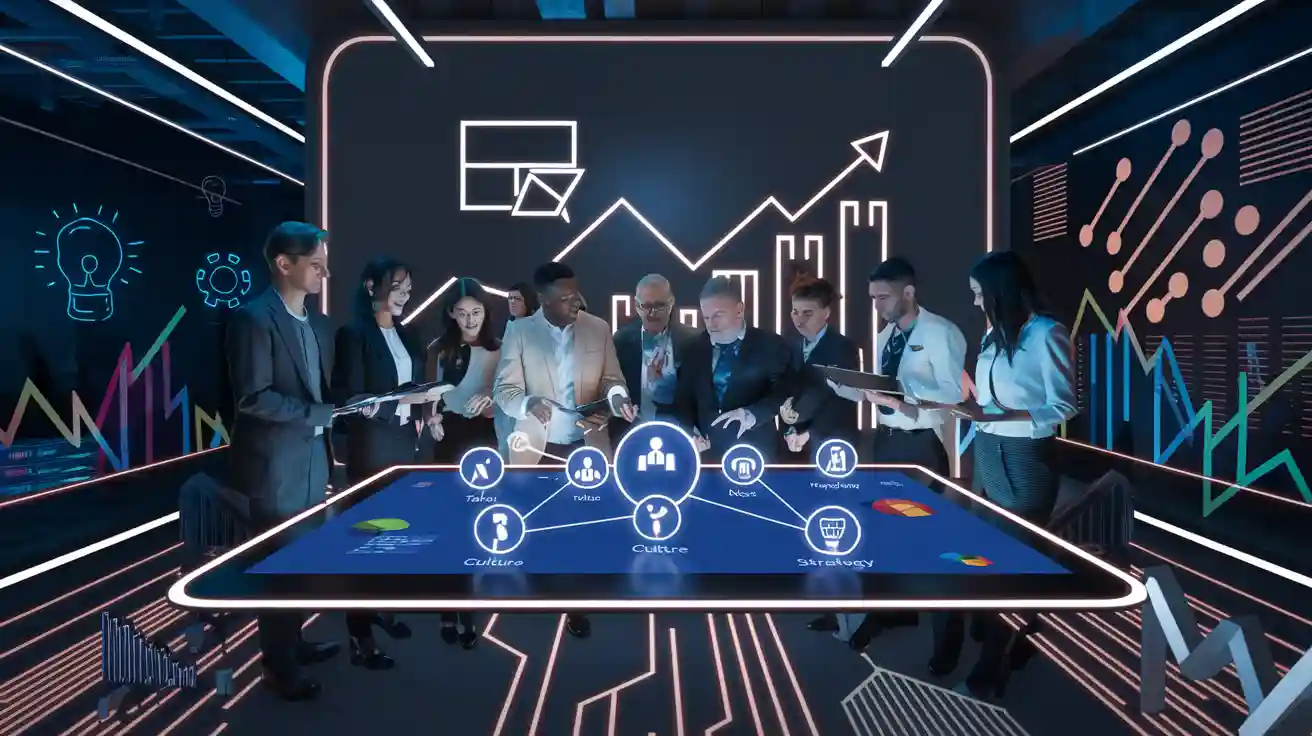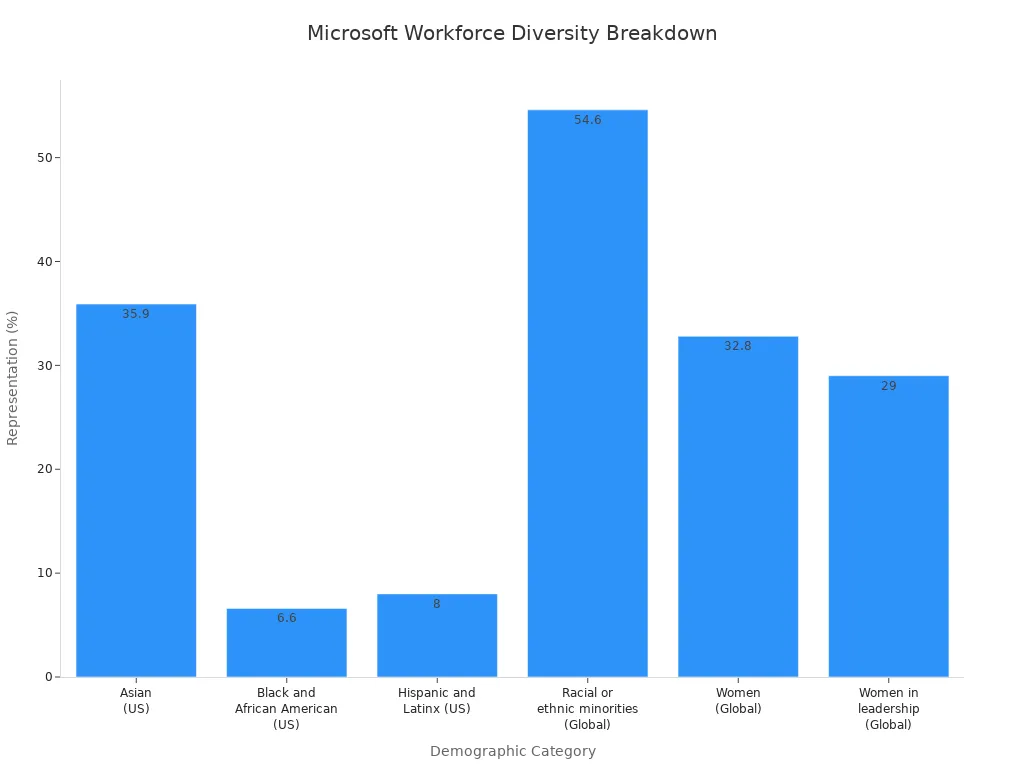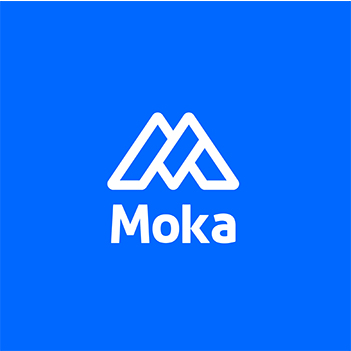Talent & Culture Strategy at MICROSOFT

Microsoft puts a growth mindset at the heart of its Talent & Culture Strategy at MICROSOFT. Satya Nadella’s leadership changed how the company treats people and performance. He took away strict systems and used reviews that reward impact, teamwork, and inclusivity. This change made culture important every day for leaders and teams. Technology, diversity, and always learning now help Microsoft build a strong culture that supports workers and gets good results.
Microsoft’s Growth Mindset
Core Philosophy
Microsoft thinks a growth mindset helps people learn and work better. Leaders want workers to see hard things as chances to grow. They hope everyone learns from mistakes and keeps getting better. This way, people can try new ideas without being scared. Workers feel okay asking questions and sharing thoughts. The company likes curiosity and learning more than being perfect.
Satya Nadella, who is Microsoft’s CEO, talks a lot about growth mindset. He wants teams to care about getting better, not just winning. This idea helps people come up with new things. It keeps Microsoft strong in technology. The company uses this idea for hiring, training, and daily jobs.
“We want to be a company where people can do their best work and grow every day,” says Nadella.
Impact on Company Culture
The growth mindset changes how people act at Microsoft. Teams help each other and work together. People share what they know and help others do well. Leaders give rewards for teamwork and learning, not just for doing well alone. This makes a good place where everyone feels important.
Microsoft’s culture now likes different ideas and backgrounds. Workers from many places bring new skills and ways of thinking. The company listens to feedback to make the culture better. Managers hear what workers say and use their ideas. This open way helps people trust each other.
Workers feel happy to be in a place that cares about growth.
Teams fix problems faster because they learn from each other.
The company gets great workers who want to grow and help.
Microsoft’s culture is special in the tech world. The focus on growth mindset helps the company change and lead with strength.
Talent & Culture Strategy at Microsoft
Key Pillars
The talent & culture strategy at microsoft is built on three main ideas. These ideas help the company grow and stay strong in a world that changes fast.
Growth Mindset: Microsoft thinks everyone can get better and learn more. The company wants workers to try new things and learn from mistakes. This way, teams can be creative and ready for change.
Diversity and Inclusion: The talent & culture strategy at microsoft works to bring people from many backgrounds together. The company has programs to help more women, Black, African American, Hispanic, and Latinx employees join and move up. Employee resource groups and allyship programs make everyone feel welcome.
Continuous Learning: Microsoft wants workers to keep learning new things. The company gives training, career help, and support for growth. This helps workers face new problems and keeps the company strong in technology.
The company checks how it is doing with diversity and inclusion. The table below shows the newest numbers for Microsoft’s workers:
Demographic Category | Percentage / Representation | Change Since 2020 |
|---|---|---|
Asian (US workforce) | 35.9% | +1% |
Black and African American (US) | 6.6% | +1.9% |
Hispanic and Latinx (US) | 8% | +1.6% |
Racial or ethnic minorities (Global) | 54.6% | N/A |
Women (Global) | 32.8% | +2.6% |
Women in leadership (Global) | 29% | +5% |
Black and Latinx in executive roles (US) | Less than 5% | Just over +1% |

Microsoft knows there is more to do. Programs like Leap and Aspire help bring in more people from different backgrounds, especially for new jobs. The company’s chief diversity officer, Lindsay-Rae McIntyre, says the number of different people is growing, but there is still room to get better.
Leadership and Transformation
Leaders are very important in the talent & culture strategy at microsoft. Satya Nadella, the CEO, changed how the company works. He helped Microsoft go from “know-it-all” to “learn-it-all.” This made the culture more open and focused on learning.
Kathleen Hogan, the Chief People Officer, helps with this change. She works to make a place where everyone feels safe to share ideas. Leaders now act like coaches. They listen, care, and help workers grow. This new way makes the culture stronger and brings people together.
The company also changed how teams work. The “One Microsoft” idea helps break down walls between groups. Teams now share goals and help each other more. The company’s structure is flatter, so decisions are made faster. Workers feel closer to leaders and can give feedback easily.
Microsoft’s talent & culture strategy at microsoft keeps changing to meet new business needs. The company added flexible work and well-being programs. Leaders focus on what customers need and want teams to solve real problems. The strategy helps Microsoft stay strong and ready for what comes next.
Note: Microsoft’s culture keeps growing. The company changes its talent & culture strategy at microsoft to face new challenges and help its people.
Employee Retention
Employee Experience
Microsoft works hard to make employees happy at work. The company uses Microsoft Viva to help workers feel connected and healthy. Viva lets people share feedback and stay in touch, even when working from home or office. Microsoft also uses AI tools like Copilot to help with daily jobs. Many workers say these tools help them finish work faster and better. New features in Microsoft Teams make sure everyone can join meetings. The company also adds smart technology to offices. This makes work easier and more fun for everyone.
Initiative | Description | Observed Outcomes |
|---|---|---|
Microsoft Viva | Connects employees, supports wellbeing, and collects feedback | Better connection and wellbeing in hybrid work |
AI Tools (Copilot, Chat) | Helps with emails, meetings, and information | 70% report higher productivity; 68% better work quality |
Hybrid Meeting Enhancements | Makes meetings more inclusive and engaging | Meeting satisfaction up by 31 points |
Smart Workspaces | Uses technology for easier check-in and space management | More efficient and enjoyable workspaces |
Rewards and Benefits
Microsoft gives rewards and benefits that are as good as or better than other companies. Workers get good pay, bonuses, and stock options. They also get strong health plans and free mental health help. Family support includes paid time off and help with adoption or fertility. Microsoft helps workers learn new things with yearly budgets and LinkedIn Learning. These rewards make workers feel important and cared for.
Benefit Category | Microsoft Offering | Industry Comparison |
|---|---|---|
Pay and Performance | Competitive pay, bonuses, stock options | Meets or exceeds tech sector standards |
401(k) Matching | 50% match up to $11,250 per year | More generous than many tech companies |
Health and Wellness | Full health plans, free mental health counseling | More extensive than average |
Family Support | 12-20 weeks paid leave, adoption and fertility benefits | Exceeds most tech companies |
Learning and Growth | Annual learning budgets, mentorship, LinkedIn Learning | Stronger focus on continuous learning |
Wellbeing and Flexibility
Microsoft cares about workers’ health and flexible work. The company lets people pick work hours that fit their lives. Microsoft Viva helps workers stay healthy and connected. Teams has mindfulness tools with guided meditations. Flexible hours help workers feel less stress and balance life and work. For frontline workers, Microsoft has part-time jobs and job sharing. These programs show Microsoft wants workers to feel good and meet their needs.
Program/Initiative | Description | Impact/Participation |
|---|---|---|
Lets employees manage work and personal life | ||
Mindfulness in Teams | Guided meditations for stress relief | Participation rates not specified |
Frontline Worker Flexibility | Part-time jobs, job shares, family contracts | 44% left jobs due to lack of flexibility |
Flexible Scheduling Benefits | Reduces stress, supports wellbeing | Higher engagement and profitability |
Microsoft’s focus on making work better, giving good rewards, and helping with health and flexibility makes people want to stay and grow.
Company Culture

Collaboration and Openness
Microsoft’s company culture is built on trust and respect. Leaders want workers to share ideas and listen to each other. People feel safe to speak up and try new things. The 'Code of Us' helps teams value every voice and work together. This makes it easier for people from different backgrounds to solve problems as a team.
Everyone feels heard and respected at work.
The company shares workforce data in its yearly Diversity & Inclusion Report.
Teams use stories and real-life examples to connect and learn.
Microsoft works with partners to help workers and communities.
The company values both teamwork and being yourself.
Microsoft’s culture is special because it welcomes new ideas. Leaders care about what workers think. This trust helps teams work fast and find better answers. The culture gets stronger when everyone feels included and important.
Empathy and Inclusion
Empathy is a big part of Microsoft’s culture. Leaders want workers to care about and help each other. Managers get training to listen and show care for their teams. This focus on empathy builds trust and makes work safer for all.
Inclusion is also very important at Microsoft. The company hires people from many backgrounds and gives everyone a fair chance to grow. Employee resource groups help workers connect and share their stories. The company celebrates differences and learns from them. This helps Microsoft find great workers and keep them happy.
When workers feel understood and included, they do their best work. Microsoft’s culture uses empathy and inclusion to build strong teams and lasting success.
Talent Acquisition Strategy
Hiring Practices
Microsoft hires people by looking at their skills. The company cares about what people can do and how they might grow. It does not just look at where someone went to school or how long they have worked. This way, Microsoft finds people with many backgrounds and ideas. Everyone who helps hire gets training to notice and stop bias.
Microsoft now recruits from over 600 colleges, not just top schools.
The company does not use employee referrals for college hiring anymore.
These steps help Microsoft find more people and make teams more diverse.
Now, women make up over 30% of Microsoft’s workers worldwide. More than 53% of U.S. workers are racial or ethnic minorities.
Lauren Gardner, who leads global talent acquisition, says Microsoft always asks, “What skills do you have? What can you learn? How can we show that?” Focusing on skills helps Microsoft change when business needs change.
Microsoft’s hiring practices prioritize skills and potential over traditional metrics like school prestige, fostering diversity by recruiting from over 600 colleges and eliminating employee referrals for campus hiring. With training to reduce bias, Microsoft’s workforce now includes over 30% women globally and 53% racial or ethnic minorities in the U.S. These principles align with modern Applicant Tracking Systems (ATS), which enhance candidate experience through AI-driven job matching, streamlined applications, transparent tracking, and bias detection tools, while boosting HR efficiency with automated screening and collaborative workflows.
AI and Technology Integration
Microsoft uses new technology to make hiring better and faster. The company’s AI-powered applicant tracking system uses Microsoft Power Platform and Azure Cognitive Services. These tools do many tasks that used to take a lot of time. Power BI reports show numbers like how much hiring costs and how long it takes. This helps leaders make smart choices.
A special FAQ tool made with Power Apps gives fast answers to hiring questions. Azure Cognitive Search uses machine learning to find top candidates and answer questions quickly. Power Automate links these tools, so recruiters get the right information right away.
How AI-ATS help
The AI-powered ATS gives many good results:
It makes hiring new people faster.
It cuts down hiring costs.
It helps recruiters find and talk to the best people quickly.
It makes hiring fair and uses data to help.
Microsoft’s talent acquisition strategy uses both people and technology. The company changes its plan to meet new challenges and find great talent.
Skills Development
Continuous Learning
Microsoft makes learning new things a big part of work life. The company uses Microsoft Viva Learning and LinkedIn Learning Hub. These tools give workers many courses to pick from. Employees can learn during their normal workday. They do not have to stop working to learn something new. Microsoft wants everyone to learn more than just job skills. People can also build leadership, allyship, and technical skills.
Workers use Microsoft Teams to find learning tools while they work.
The course list has topics like DevOps, Agile program management, and user-centered design.
The company checks how many "engaged quality learners" finish more than two extra courses each month.
After starting this new way to learn, Microsoft saw a 58% jump in engaged quality learners. This means more people are using the learning tools. It shows that workers want to grow and get better. Leaders care about real learning and changing how people work, not just finishing classes. Microsoft will add AI-powered learning, content ratings, and special time for training. These changes will help workers learn even more.
Other big tech companies also spend money on learning. But Microsoft is different because learning is part of daily work. The "Customer Zero" idea lets workers try new tools first. This helps the company come up with new ideas. AI helps workers keep learning and get ready for new jobs in cloud and AI.
Internal Mobility
Microsoft helps workers move to new jobs inside the company. Employees can switch teams, roles, or even business units. The company wants people to look for new chances and learn new things.
Managers help by coaching workers through career changes. Microsoft’s job board shows open jobs and makes it easy to apply. The company cares about skill building and helps workers who want to try something different.
When workers move to new jobs, they bring new ideas and energy. This helps Microsoft keep great workers and build strong teams.
Microsoft’s focus on learning and moving inside the company makes a place where people can grow, change, and do well.
Measuring Progress
Feedback Mechanisms
Microsoft cares about what workers think. The company asks workers for their ideas often. They use surveys to learn about the workplace and leaders. Workers can share thoughts using Microsoft Viva. Viva collects feedback right away. Managers look at this feedback to find problems fast. Microsoft also has listening sessions. Leaders talk with teams about problems and ways to get better.
Workers can use suggestion boxes and online forums. These let people share worries without saying their names. These tools help leaders know what is good and what needs fixing. Microsoft wants managers and workers to talk openly. This helps everyone trust each other and makes it easier to help workers.
Note: Feedback is not just for show. Leaders use what they learn to make new programs and rules.
Data-Driven Insights
Microsoft uses data to see how well things are going. The company checks numbers to see if it meets diversity and inclusion goals. Leaders look at data about hiring, promotions, and keeping workers. This helps them find problems and ways to improve.
Microsoft shares reports with everyone who cares about the company. These reports show how Microsoft keeps its promises about talent and culture. All reports are in one place called the Reports Hub. This makes it easy to find and read them.
Some important things Microsoft tracks are:
How many women and minorities work at Microsoft
How close they are to meeting diversity goals each year
How happy and engaged workers feel
Metric | How Microsoft Measures |
|---|---|
Workforce Demographics | Annual diversity reports |
Employee Engagement | Regular surveys and Viva data |
Progress on Inclusion Goals | Public disclosures and updates |
By using feedback and data, Microsoft makes sure its talent and culture strategy works well and is clear for everyone.
Microsoft’s growth mindset and talent strategy help workers do well and make the company strong. The company’s culture is strong because of three main ideas:
Adaptability helps teams stay strong and learn new things.
Leadership gives teams support and helps them grow, even with hybrid work.
Technology like AI and data tools helps people work better together.
Other companies can use these ideas too:
Leaders should show good values and praise hard work.
Listen to workers often and change the culture if needed.
Make sure the culture matches business goals and helps workers feel good.
Show values every day with actions and training.
Make work safe so people can share new ideas.
A strong culture helps people care more about work, stay longer, and helps the company do well for a long time.
FAQ
What is Microsoft’s approach to building a strong company culture?
Microsoft builds its culture with a growth mindset, diversity, and learning. Leaders want teams to work together and share feedback. Workers feel important and get help when needed. The company changes its plans to face new problems.
How does Microsoft support employee learning and development?
Microsoft gives tools like Viva Learning and LinkedIn Learning Hub. Workers can take classes while at work. Managers help team members learn new skills. The company checks how much people learn and gives rewards for getting better.
What role does technology play in Microsoft’s talent strategy?
Technology helps Microsoft hire, train, and support workers. AI tools make hiring faster and more fair. Online platforms help teams talk and share feedback. Workers use smart tools to do their jobs and learn new things.
How does Microsoft measure progress in diversity and inclusion?
Microsoft looks at worker data and shares reports every year. Leaders check numbers for hiring, promotions, and how happy workers are. The company sets goals for diversity. Progress shows up in public updates and on company dashboards.
See Also
Boost Employee Productivity With Effective Talent Management Tools
MokaHR Partners With C&T To Improve Talent Management Solutions
Transforming Hiring Processes Through MokaHR’s Advanced Recruitment Platform
Discover Hidden Talent Using MokaHR’s Online Management Platform
Enhancing Workforce Satisfaction With MokaHR’s Talent Management Software
From recruiting candidates to onboarding new team members, MokaHR gives your company everything you need to be great at hiring.
Subscribe for more information

